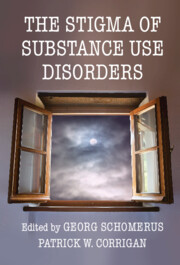Book contents
- The Stigma of Substance Use Disorders
- The Stigma of Substance Use Disorders
- Copyright page
- Contents
- Figures
- Tables
- Contributors
- Chapter 1 Understanding the Stigma of Substance Use Disorders
- Chapter 2 My Experience with the Stigma of Substance Use
- Chapter 3 Substance Use Stigma and Policy
- Chapter 4 Experiences of Stigma and Criminal In/Justice among People Who Use Substances
- Chapter 5 Substance Use Disorders, Stigma, and Ethics
- Chapter 6 Intersectional Stigma in Substance Use Disorders
- Chapter 7 International Perspectives on Stigma toward People with Substance Use Disorders
- Chapter 8 Using Community-Based Participatory Research to Address the Stigma of Substance Use Disorder
- Chapter 9 Three Competing Agendas of Addressing Stigma of Substance Use Disorder
- Chapter 10 The Benefits of Disclosure
- Chapter 11 The Role of Peers in SUD Stigma Change
- Chapter 12 The Role of Media Reporting for Substance Use Stigma
- Chapter 13 Reducing Substance Use Stigma in Health Care
- Chapter 14 Final Considerations and Future Directions for Erasing the Stigma of Substance Use Disorders
- Index
- References
Chapter 5 - Substance Use Disorders, Stigma, and Ethics
Published online by Cambridge University Press: 23 June 2022
- The Stigma of Substance Use Disorders
- The Stigma of Substance Use Disorders
- Copyright page
- Contents
- Figures
- Tables
- Contributors
- Chapter 1 Understanding the Stigma of Substance Use Disorders
- Chapter 2 My Experience with the Stigma of Substance Use
- Chapter 3 Substance Use Stigma and Policy
- Chapter 4 Experiences of Stigma and Criminal In/Justice among People Who Use Substances
- Chapter 5 Substance Use Disorders, Stigma, and Ethics
- Chapter 6 Intersectional Stigma in Substance Use Disorders
- Chapter 7 International Perspectives on Stigma toward People with Substance Use Disorders
- Chapter 8 Using Community-Based Participatory Research to Address the Stigma of Substance Use Disorder
- Chapter 9 Three Competing Agendas of Addressing Stigma of Substance Use Disorder
- Chapter 10 The Benefits of Disclosure
- Chapter 11 The Role of Peers in SUD Stigma Change
- Chapter 12 The Role of Media Reporting for Substance Use Stigma
- Chapter 13 Reducing Substance Use Stigma in Health Care
- Chapter 14 Final Considerations and Future Directions for Erasing the Stigma of Substance Use Disorders
- Index
- References
Summary
Significant issues influencing the stigmatization of substance use disorders (SUDs), like the assessment of responsibility and need for respectful relationships, involve ethical concerns. Despite this, much civic and professional debate on the topic is poorly equipped to make sound ethical judgments. This predicament is influenced by a number of obstacles. Firstly, the medical or disease model that often dominates debates in the field is characterized by a reductive science focus. This does not embrace the idea that ethical debate has an important role to play in addressing stigma. Secondly, traditional bioethics tends to be individually focused and so overlooks the social and relational issues that require attention when seeking to support recovery from a biopsychosocial condition like SUDs. After assessing these challenges, it is argued that increasing ethics literacy, as part of a broader interdisciplinary response to the stigmatization of SUDs, is critical to impact meaningfully on civic and professional debates.
- Type
- Chapter
- Information
- The Stigma of Substance Use Disorders , pp. 68 - 87Publisher: Cambridge University PressPrint publication year: 2022
References
- 1
- Cited by



